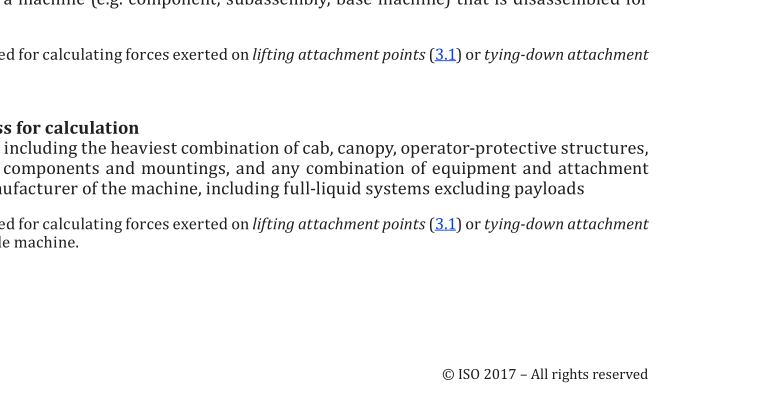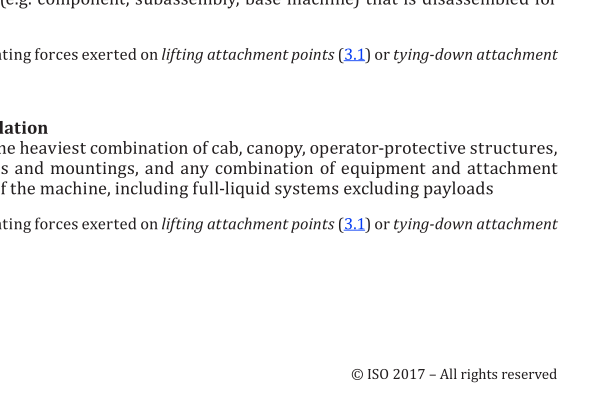ISO 15818:2017 pdf download – Earth-moving machinery — Lifting and tying-down attachment points — Performance requirements.
3.9 distributed lifting force force applied onto each lifting attachment point (3.1) from lifting equipment through lifting accessories (3.2) during lifting Note 1 to entry: The distributed lifting force magnitude and direction can be different for each lifting attachment point due to unequal distribution of loads and non-vertical lifting accessories. 3.10 distributed tying-down force restraining force force potentially applied onto each tying-down attachment point (3.3) from transport vehicle through tying-down accessories (3.4) during transport 3.11 working load limit WLL maximum load (mass) that the lifting accessory (3.2) is designed to lift under the conditions specified by the manufacturer 3.12 lashing capacity LC maximum allowable direct force that a tying-down accessory (3.4) can sustain in use 3.13 transport vehicle vehicle to which the earth-moving machine is tied down for transportation purposes 3.14 proof force calculated force including proof factor for distributed lifting force (3.9) or distributed tying-down force (3.10) 3.15 breaking force calculated force including safety factor for distributed lifting force (3.9) or distributed tying-down force (3.10) 3.16 number of effective tying-down attachment points n number of tying-down attachment points (3.3) used simultaneously in the same direction of force 3.17 number of effective lifting attachment points n number of lifting attachment points (3.1) used simultaneously 3.18 lashing restraining (as cargo) of earth-moving machine movement in relation to the transport vehicle (3.13) against forces applied on the machine during transport by means of the appropriate use of tying-down accessories (3.4) 3.19 resultant force F Rx , F Ry force acting on the tying-down attachment point (3.3) due to the direction of force relative to the transport vehicle (3.13) actuated on the load in either the x- or y- direction during transport
4 Lifting attachment points 4.1 Location and number Sufficient number of lifting attachment points shall be placed so that the lifting force derived from the machine mass is relatively well distributed and balanced during lifting with a lifting accessory or accessories. Where there is no appropriate central lifting attachment point (see Figure B.2), lifting attachment points shall be spaced the maximum practical distance for appropriate stability and balance. A lifting attachment point or points should be designed to hold the terminal fittings of the lifting accessories in the foreseen position to avoid slipping. 4.2 Strength Dependent on transport procedure, the lifting attachment points shall fulfil the strength requirements to lift the whole machine or to lift the disassembled unit. Table 1 shall be used to define strength requirements for symmetric loadings. Alternatively, taking uneven loadings into account, the strength requirement for each lifting attachment point shall be calculated individually using the mass of each disassembled unit or (3.8.1) the whole machine mass for calculation (3.8.2) and the location of the lifting points relative to the centre of the mass. A proof factor of 1,5 for the proof force and a safety factor of 4 for the breaking force shall be used in the calculations. The strength of each lifting point shall be verified according to Clause 9. Open-end lifting attachment points, such as hooks, shall have a safety latch or other device to prevent unintended disengagement of the mating lifting accessory.
ISO 15818:2017 pdf download – Earth-moving machinery — Lifting and tying-down attachment points — Performance requirements






